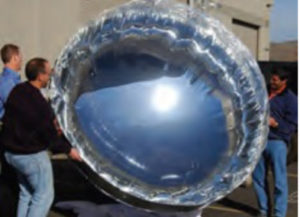Future of Solar
The future of solar couldn’t be brighter. There already are many types of solar innovations, and we should expect more in the future.

Electric Car Charging Stations
Tennessee initiatives support owners of electric cars, like the Nissan Leaf that is manufactured in our state. The Tennessee Valley Authority is also pioneering research for electric car charging stations. The prototype is called the Smart Model Area Recharge Terminal, or SMART station. It features power generation by solar photovoltaic panels, stationary battery storage of power and key elements of smart grid technology.
Sun-free photovoltaics
Researchers at MIT are working to develop materials engineered to give off precisely-tuned wavelengths of light. When heated they are key to a new high-efficiency generating system. As the material absorbs heat — whether from the sun, a hydrocarbon fuel, a decaying radioisotope or any other source — the pitted surface radiates energy, primarily at these carefully chosen wavelengths.
High efficiency solar power
Charles Fritts’ first solar cell worked at a 4 percent efficiency level, as it converted the sun’s rays into electricity. Today, scientists in labs like Oak Ridge National Laboratory are working with innovative technologies and materials, that rate as highly as 28.2 percent efficiency– making solar nearly as efficient as burning fossil fuels such as coal and oil.

Inflatable balloons to deflate costs
There are many efforts underway to bring down the cost of photovoltaic solar cells. One of these innovations uses inflatable solar collectors. These balloons, made of plastic film, are as much as 400 times less expensive than solar concentrators that are made of polished aluminum.

Algae as biofuel
Researchers at facilities such as NASA have found that by growing algae in strategic locations, the U.S. could produce 21 billion gallons of algal oil which can be turned into biodiesel to power our cars and even jet planes. The 21 billion gallons of algal oil is equal to the 2022 advanced biofuels goal set by the 2007 Energy Independence and Security Act and algal oil could replace up to 17 percent of U.S. oil imports.

Mimicking nature
Biomimicry is using nature as inspiration for solving human problems. Human flight is an example which was inspired by birds, and now many technologies in the solar industry mimic nature. This includes solar panels that track the sun in the same way sunflowers do.
Biomimicry is being used to increase the efficiency of solar cells. Because the silicon used in photovoltaic cells is highly reflective a lot of the sun’s light bounces off and energy is lost. Researchers noticed that moths’ eyes don’t reflect much light – probably to protect them from predators at night. This observation was the inspiration for the “moth-eye” process of creating solar panels that reflect less than 2% of light.

Butterflies inspired other photovoltaic solar scientists. They noticed that butterfly wings have scales that act like tiny solar collectors. Scientists made molds of the wings and turned them into sunlight-collecting structures. The result is a highly efficient cell that is simpler and faster to make than conventional solar cells.

“Hairy” Solar Panels
Researchers are experimenting with producing light-absorbing nanowires – smaller than the eye can see – on carbon-nanotube material. The scientist’s goal is to grow high efficiency photovoltaic material to produce inexpensive and high performance solar cells.

Solar Power Station in Space
In as little as 20 years from now, there may be an electrical power station in space. One plan researchers are working on is using solar collectors several miles above Earth that would orbit around the equator, allowing capture of the sun’s rays around the clock. Once the solar energy is collected, the satellites would then convert it into consumable energy to be beamed back to Earth in the form of microwave energy or even lasers.
Solar Powered Clothing
There is a new trend in fashion: solar energy. For people who love the outdoors and want to take their personal electronics with them, they can wear jackets that include small solar panels in the collar—enough to charge their phones or music devices.
Solar Desalination
Solar desalination plants are using the sun’s energy to boil water from oceans, lakes, streams and ponds. The water vapor changes into steam. When the steam cools and condenses, it becomes water that is safe to drink or to irrigate crops. Solar desalination is also a process that can be used in areas that do not have easy access to clean drinking water.
Dye-Sensitized Solar Cells
Unlike conventional silicon-based solar cells, dye-sensitized solar cells consist primarily of photosensitive dye and other substances. They generate electricity by converting energy from light absorbed by the dye. Since these solar cells can be produced from low-cost materials using simple manufacturing processes (such as coating and printing), manufacturing is less expensive. Dye-sensitized solar cells also perform well indoors and in low light settings. In addition, they can be incorporated into the architecture of buildings as walls or windows instead of using solar panels on the building’s roof.
Tennessee Powers Up for the Future of Solar
The future of solar in Tennessee—from research to product manufacturing and installation – depends on educating you, as today’s students and citizens, to be ready for those jobs. Across the state, there are programs and initiatives that are taking exciting steps toward our state’s bright future in solar.
Solar Entrepreneur
Stanford student Jason van der Merwe may be a college student now, but as a high school student in Knoxville his ideas for next generation solar power were so intriguing that he and his partner, Aneesha Raghunathan, won the competition Global Challenge. Their concept is that, because dye-sensitized solar cells are made of a plastic just like that is used in the majority of cell phones, using natural plant dyes can turn cell phones into a next-generation solar powered device that would never run out of power.

4-H
Tennessee 4-H is the youth program of the University of Tennessee Extension and Tennessee State University Extension. It encourages diverse groups of youth to develop their unique skills and talents to the fullest potential. Through hands-on activities and community involvement 4-H’er’s develop and strengthen life skills.
One of the opportunities through 4-H to learn about energy and electricity is Electric Camp. Like all 4-H programs, Electric Camp is hands-on and fun-filled learning. Electric Camp is held at the University of Tennessee in Knoxville each summer. Campers, who are 6th and 7th graders, learn what electricity is, how it works and explore careers in energy, electricity and basic sciences. Learning is guided by electrical specialists from across the state in learning centers.
Careers of the Future
When you are thinking about what you want to be when you grow up, here a few things to think about. The future of every form of renewable energy – including solar – depends on people with big ideas and a strong background in science. They’re all exciting.
In your classes at school, be sure to pay attention and study hard in science and math, join science clubs and compete in science fairs. If your school doesn’t have science clubs or science fairs, then ask your teachers or principal about starting them.
- Climatology
- Computer Science
- Architecture
- Agriculture
- Botany
- Chemistry
- Geology
- Hydrology
- Information Technology
- Environmental Engineering
- Chemical Engineering
- Mechanical Engineering
Most jobs in clean energy, including solar energy, look a lot like many of the jobs people work in today. Construction workers install solar arrays on the roofs of buildings and engineers design the technology that makes the array convert solar energy into electricity. Making buildings more energy-efficient will mean jobs for roofers, insulators and building inspectors.
There is a place in renewable energy for everyone.
Investing in the future of solar
The growing industry means the addition of more jobs here in Tennessee, and across the U.S. Jobs in the upcoming solar market include:
- Solar Cell and Module Manufacturing
- Photovoltaic Equipment Manufacturing
- Balance of Systems Manufacturing and Supplies
- System Integration and Packaging Companies
- Distributors
- Installation, Service and Repair
- Sales Representative
- Marketers
- Estimators
- Site Surveyors and Assessors
- Researchers
- Scientists
- Engineers
- Designers
- Trainers
- Educator
- Architects
- Builders
- Roofers
- Electrical Workers
- Metal Workers
- HVAC Installers
- Plumbers
- Electric Power Utility Workers
- Finance
- Policy and Program Managers
- Suppliers of Commodities such as glass, electronic devices, plastics, polymers, wire and cable, steel, aluminum and other metals
